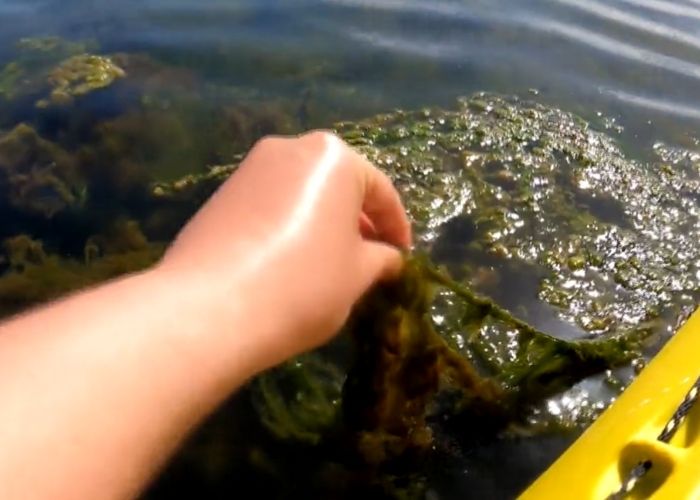SAN PEDRO DEL PINATAR – The Mar Menor and the tourism industry that depends on it are crying out for help. The inland sea is giving alarming signals. Large amounts of algae again indicate an excessive amount of nutrients from the intensive agriculture in the area.
The signals that Mar Menor continues to send herald a new environmental disaster, several Spanish media wrote last weekend. In the deeper parts of this largest inland sea in Spain, a process of eutrophication leads, just like last year, to a new “green soup”.
Serious consequences for Mar Menor tourism
The neglect and deterioration of the inland sea are seriously affecting hotel reservations and the economic activity of the whole area. Moreover, significant losses are already being incurred. “It will be a shock to the area’s economy if it happens again,” explained a resident.
Residents are “very concerned”
The hotels in the area still have no reservations for July and August. Furthermore, reservations that were standing have been cancelled. “I don’t think people from outside the region will come,” says the owner of a shop in the area. The situation makes residents “very concerned”. “For our economy, Mar Menor is our source of life,” says the owner of another business.
The residents of the saltwater lagoon in the Murcia region have long been asking for solutions. If the lagoon dies, so will companies in the tourism sector of Mar Menor, with dire consequences for the inhabitants.
No tourists but plenty of algae
With the rising temperatures, tourists usually come to spend their holidays in one of the many hotels or apartment complexes in the area. Now algae are the only ones to multiply in the perfect breeding ground full of nitrates. It involves a rapid growth of algae known as angel hair (Chaetomorpha linum) mixed with other types of algae.
Very high levels of nitrogen
The latest readings indicate that “very high levels” of nitrogen are coming in, about 21,000 kilograms per day, warned Emilio Maria Dolores, chair of the scientific committee that monitors the lagoon, in late April.
This alarming situation “marks the beginning of eutrophication”. Consequently, if this is not stopped, will likely mean that “the situation is the same or worse than last year”. In August 2021 there was a large fish kill due to a lack of oxygen.
Remove algae
The strip of algae detected in the La Manga area is about 100 metres offshore. Furthermore, it is about two kilometers long and about 50 metres wide on average. This is according to calculations by the Platform for the Mar Menor.
Las imágenes son escalofriantes. Auténticas marañas de algas colonizan algunas zonas del Mar Menor y encienden las alarmas ante un posible desastre ecológico. Un reportaje de @Carmenrrojas2 y Patricia Ribas en @InformeSemanal . A las 21.30 en @La1_tve pic.twitter.com/vIVpteEMui
— Informe Semanal (@InformeSemanal) May 7, 2022
The regional government has been working for a few weeks to remove these algae from the water. In April alone, 2,400 tons were extracted. Removing algae manually is the only method available to prevent them from decomposing on the coast by forming a slime that moves and which, with the appearance of phytoplankton (composed of microscopic organisms), leads to a decrease in oxygen. So far, more than 10,000 tons of biomass and algae have been removed.
“The Murcians from the area are fighting,” one resident told Telecinco. “I believe this problem has a solution, but I don’t know if the politicians want to take it,” he added.
“Never seen anything like it”
Isabel Rubio, an employee of the Platform for the Mar Menor tells El País how in February she saw by kayak how the banks were already full of the same algae. Last month she saw a silver stripe in the sea and decided to take a look with her kayak. “What we found was terrible. I’m out of words to describe the disaster. Furthermore, I’ve never seen anything like it in La Manga.”
Most polluting discharge continues
Meanwhile, one of the most polluting discharges, the Rambla del Albujón, is still the dumping ground for phosphorus and nitrates from the area’s intensive agriculture. No less than a thousand liters per second flow into the lagoon.
Lowering the water table
The scientific committee points out that the only solution to prevent the Mar Menor from reaching a point of no return is to lower the water table of the aquifer. Furthermore, this is located between 16 and 17 metres above sea level. For decades, this water has been the source of discharges from agricultural businesses and farms, along with the remains of fertilisers and pesticides (nutrients) they use.
The lagoon “is a system that the more we feed it naturally responds by consuming the nutrients.” When solar radiation is added, more phytoplankton is produced, the water turns green and more macroalgae are born.
The same has been said for six years
Angel Pérez Ruzafa, a member of the scientific committee, said he was desperate that they were “saying the same things for six years” when they “associated the eutrophy situation with nutrient ingress from the water table.
Lost six years
He blames the Ministry of Ecological Transition for not stopping the deterioration because “agricultural control measures are good and necessary, but not sufficient.” In his opinion, “six years have been lost” to set up the infrastructure that will allow the polluted water to be diverted, treated, and prevented from reaching the inland sea.
Ex-president admits guilt
Meanwhile, the former president of the Murcia region has confessed that the state of the lagoon is “getting out of control”. Ramón Ruiz Valcárcel admits his guilt for the Mar Menor crisis “as the PP and PSOE should do”. and the riverside communes which for the most part belonged to the PSOE”.


